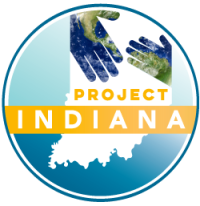Project Trips
2012 Project: Nueva Esperanza, Hoja Blanca, Las Cueva and Las Nubes, Guatemala
In the late summer of 2012, 28 lineworkers and four supervisors from 17 Indiana electric cooperatives ventured to a remote 7,000-foot-high mountain range in western Guatemala for the first-of-its-kind mission trip involving Hoosier co-op workers. During two two-week shifts, the crews labored under primitive conditions across the most rugged and dangerous terrain they’d ever encountered doing what they do daily along country roads and across fields and forests in rural Indiana. When they were done, they had constructed 20 miles of power lines by hand to bring electricity to four villages — Hoja Blanca, Las Cuevas, Las Nubes, and Nueva Esperanza — and introduce new opportunities to some 1,000 impoverished men, women and children. After seeing firsthand the needs of the villagers, and how grateful they were to finally have electricity, those at Indiana’s electric cooperatives knew their mission to help change lives was just beginning.
2015 project: Sepamac, Guatemala
Project leader Gayvin Strantz told the 14 lineworkers making the trip to Sepamac, Guatemala, that “This would be both the toughest and the best job you’ll ever have.” For two weeks, from April 19-May 4, that was certainly the case. With the mantra “improvise, adapt and overcome,” the crew fought dehydration in the 100-110 degree heat. Sepamac is located in a mountainous jungle in northeastern Guatemala and the terrain itself offered unique physical challenges to the Indiana group. The staking sheet detailed other challenges: stringing 11 miles of wire, connecting 76 primary and secondary poles and securing them with 96 anchors — by hand! Yet the Project Indiana team accomplished all that, with two days to spare. That gave team members enough time to electrify the local school. And before they left, they passed around one of their hard hats to collect $600 from their own pockets to provide supplies for the Sepamac school. They also collected money for an impoverished village family. Before the Project Indiana team left for home, Strantz told the villagers, “You’ll forever have a place in my heart and the hearts of these men, in letting us come and help you.”
2017 project: El Zapotillo, Guatemala
On their third trip to Guatemala, Indiana’s lineworkers spent two weeks in El Zapotillo, Guatemala, near the country’s southwestern border with Mexico. The crew of 16 had to adapt to the high altitude — working as high as 10,000 feet in the mountains — while building 32 miles of line, all by hand and without modern conveniences like bucket trucks. The lineworkers set only one pole while there; over 50 others had previously been set by hand by local villagers. During their time in Guatemala, the lineworkers electrified 60 homes, a school and a church — and built strong relationships with the villagers, especially the children whose lives will forever be changed because they now have electricity.
2019 project: San Jacinto, Guatemala
Fourteen lineworkers from 12 Indiana electric cooperatives, along with four project managers and support staff, were part of Project Indiana’s fourth trip to Guatemala. This time, the Indiana crew helped bring electricity to San Jacinto, a village of about 150 families in the steep hillsides of eastern Guatemala. In two weeks time, they built 4.3 miles of power lines and wired almost 90 homes, two churches and a school. Unlike the previous trips, Project Indiana included an agreement with the village and their electric utility that every home the Hoosiers wired for electricity have a properly vented wood-burning cooking stove installed to replace the open fires villagers have used for years. Prolonged exposure to the smoke resulting from those fires leads to respiratory infections, eye damage, heart and lung disease, and lung cancer. Among the 4.3 million people who die from the consequences of smoke emission each year, 500,000 are children under the age of 5 who die due to acute respiratory infections. Because of Project Indiana’s ongoing commitment to help developing communities, not only are Indiana’s electric cooperatives changing lives, they’re saving them.
2023 project: Peña Roja, Guatemala
Fourteen lineworkers from 14 Indiana electric cooperatives, along with four project managers and support staff, were part of Project Indiana’s fifth electrification project in Guatemala. On this trip, the crew helped bring electricity to Peña Roja, a village of 26 families high in the mountains of western Guatemala. In two weeks, they built 3.75 miles of power lines and wired 30 homes. The team also completed maintenance on an existing three-pole span near the Guatemalan-Mexican border.
Other resources

